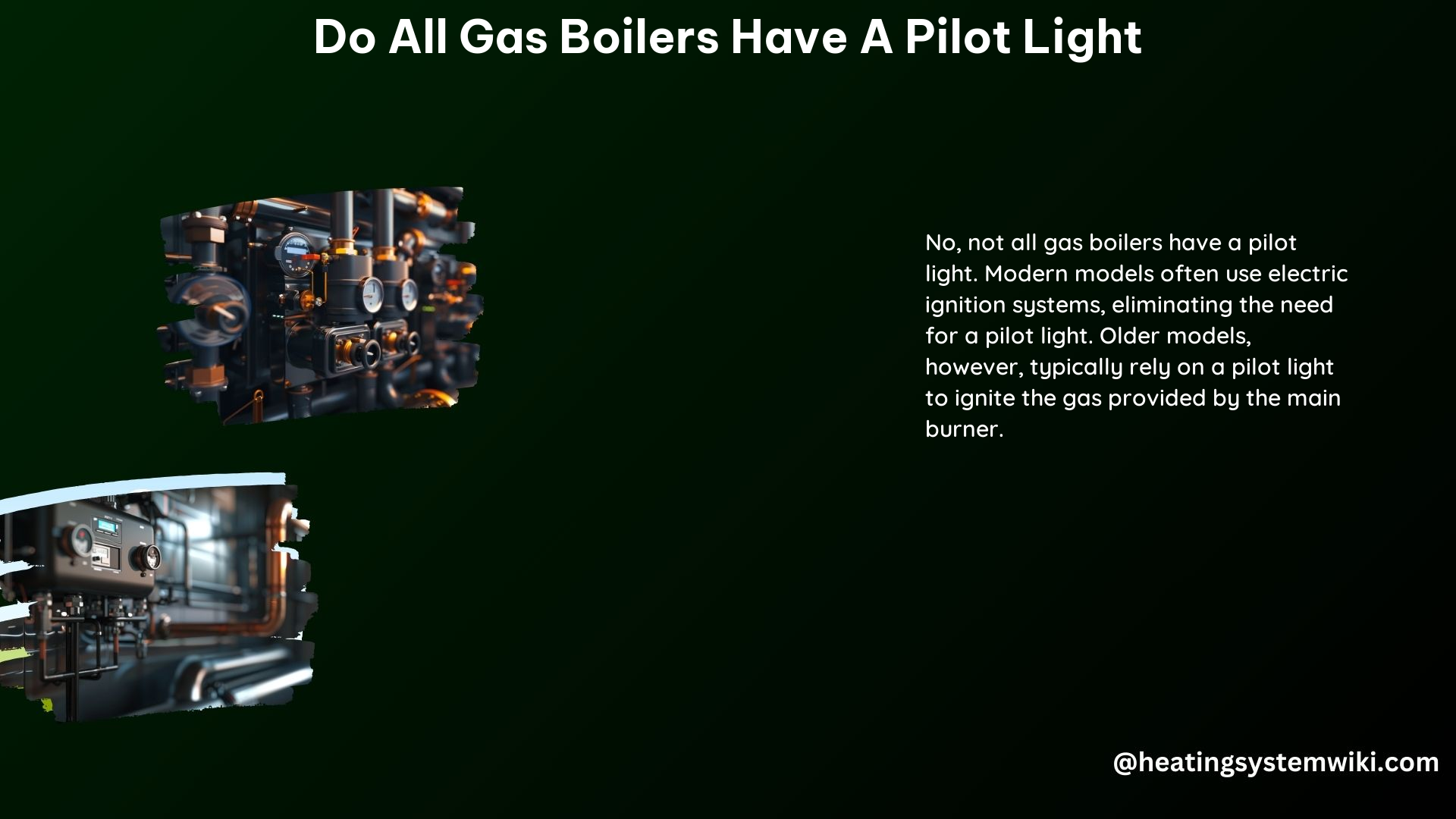Not all gas boilers have a pilot light. While older gas boilers typically rely on a pilot light to ignite the gas, newer models often use electronic ignition systems instead. These electronic systems, such as hot surface igniters or intermittent pilot lights, only ignite the gas when needed, making them more efficient and safer than traditional pilot lights.
Understanding Pilot Lights in Gas Boilers
A pilot light is a small, continuously burning flame that is used to ignite the main burner of a gas appliance, such as a boiler. The pilot light is typically located near the main burner and is lit by an electric spark or a manual ignition source, such as a match or a lighter.
When the main burner is turned on, the gas flows to the pilot light, which then ignites the main burner. This process ensures that the main burner is always ready to be ignited, even if the power is out or the electronic ignition system fails.
Pilot lights have been used in gas boilers for decades, but they have several drawbacks:
-
Energy Waste: Pilot lights consume a small amount of gas continuously, even when the boiler is not in use. This can lead to higher energy bills and increased greenhouse gas emissions.
-
Safety Concerns: Pilot lights can be a potential fire hazard, especially if they are not properly maintained or if the gas line is leaking.
-
Maintenance: Pilot lights require regular maintenance, such as cleaning and adjusting, to ensure they are working correctly.
Electronic Ignition Systems in Gas Boilers

To address the drawbacks of pilot lights, many modern gas boilers use electronic ignition systems instead. These systems use either a hot surface igniter or an intermittent pilot light to ignite the gas when the boiler is called to operate.
Hot Surface Igniters
Hot surface igniters are electronic devices that use a heated element to ignite the gas. When the boiler is called to operate, the hot surface igniter heats up and then ignites the gas. Once the main burner is lit, the hot surface igniter turns off, saving energy and reducing the risk of fire.
Hot surface igniters are typically more reliable and efficient than traditional pilot lights, and they require less maintenance. They also have a longer lifespan, with an average of 10,000 to 20,000 hours of use before needing replacement.
Intermittent Pilot Lights
Intermittent pilot lights are a hybrid between traditional pilot lights and electronic ignition systems. These systems use a small pilot light that is only lit when the boiler is called to operate. Once the main burner is lit, the pilot light is extinguished, saving energy and reducing the risk of fire.
Intermittent pilot lights are more efficient than traditional pilot lights, but they still require some gas consumption and maintenance. They are a good compromise between the reliability of a pilot light and the efficiency of an electronic ignition system.
Factors Affecting the Presence of Pilot Lights in Gas Boilers
The presence of a pilot light in a gas boiler can be influenced by several factors, including:
-
Boiler Age: Older gas boilers are more likely to have a pilot light, while newer models often use electronic ignition systems.
-
Boiler Type: Some types of gas boilers, such as wall-mounted or combi boilers, are more likely to have electronic ignition systems than floor-standing boilers.
-
Boiler Efficiency: High-efficiency gas boilers are more likely to use electronic ignition systems to maximize energy savings and reduce greenhouse gas emissions.
-
Boiler Manufacturer: Different boiler manufacturers may have different preferences for ignition systems, with some favoring pilot lights and others preferring electronic ignition.
-
Regional Regulations: In some regions, there may be regulations or incentives that encourage the use of electronic ignition systems over pilot lights.
Maintenance and Troubleshooting Pilot Lights in Gas Boilers
If your gas boiler does have a pilot light, it’s important to maintain it properly to ensure safe and efficient operation. Here are some tips for maintaining and troubleshooting pilot lights:
-
Cleaning the Pilot Light: Periodically clean the pilot light assembly to remove any dirt or debris that may be interfering with the flame.
-
Adjusting the Pilot Light: Ensure that the pilot light flame is the correct size and color. Adjust the flame as needed by turning the adjustment screw on the gas control valve.
-
Checking for Gas Leaks: Regularly check the pilot light and gas line for any signs of gas leaks, such as a hissing sound or the smell of gas.
-
Relighting the Pilot Light: If the pilot light goes out, follow the manufacturer’s instructions to relight it. This may involve pressing a button or turning a knob to allow gas to flow to the pilot light.
-
Replacing the Thermocouple: If the pilot light keeps going out, the thermocouple (a safety device that shuts off the gas if the pilot light goes out) may need to be replaced.
-
Upgrading to an Electronic Ignition System: If you’re tired of dealing with the maintenance and safety concerns of a pilot light, consider upgrading your gas boiler to an electronic ignition system.
Conclusion
In summary, not all gas boilers have a pilot light. While older models typically rely on a pilot light to ignite the gas, newer gas boilers often use electronic ignition systems, such as hot surface igniters or intermittent pilot lights. These electronic systems are more efficient, safer, and require less maintenance than traditional pilot lights.
When it comes to gas boilers, the presence of a pilot light can be influenced by factors such as the boiler’s age, type, efficiency, manufacturer, and regional regulations. If your gas boiler does have a pilot light, it’s important to maintain it properly to ensure safe and efficient operation.
References:
– Pilot Light vs. Electronic Ignition: What’s the Difference?
– How to Maintain a Pilot Light on a Gas Boiler
– The Pros and Cons of Pilot Lights in Gas Appliances
